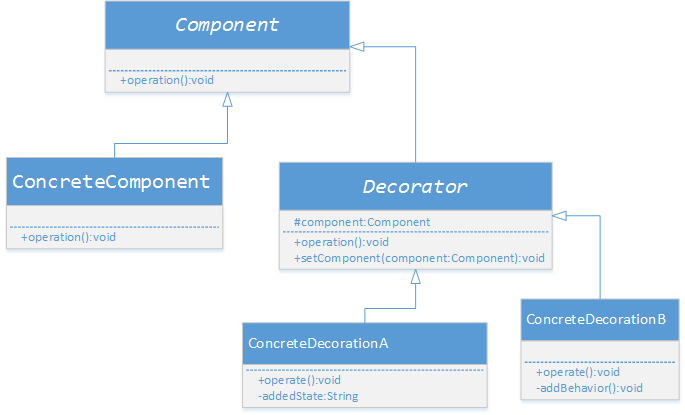装饰者模式--穿什么有这么重要?
装饰者模式:动态地给一个对象添加一些额外的职责,就增加功能来说,装饰模式比生成子类更为灵活。
装饰者模式是为已有功能动态地添加更多功能地一种方式。当系统需要新功能的时候,是向旧的类中添加新的代码。这些新加的代码通常装饰了原有类的核心职责或主要行为。装饰者模式他把要装饰的功能放在单独的类中,并让这个类包装他所需要装饰的对象,因此,当需要执行特殊行为时,客户代码就可以在运行时根据需要有选择地、按顺序地使用装饰功能包装对象了。(核心思想)
装饰者模式是为已有功能动态地添加更多功能的一种方式。
装饰者模式的优点:把类中的装饰功能从类中搬移出去,这样可以简化原有的类。有效地把类的核心职责和装饰功能区分开了,而且可以去除相关类中重复的装饰逻辑。
装饰模式的装饰顺序很重要,最理想的情况,是保证装饰类之间彼此独立,这样他们就可以以任意的顺序进行组合了。
1 //Component是定义一个对象接口,可以给这些对象动态地添加职责 2 public abstract class Component { 3 public abstract void operation(); 4 }
1 /** 2 * 定义了一个具体的对象,也可以给这个对象添加一些职责,一般不在这里添加 3 * @author 贤元 4 * 5 */ 6 public class ConcreteComponent extends Component { 7 8 @Override 9 public void operation() { 10 System.out.println("具体对象的操作---被装饰的对象"); 11 } 12 13 }
1 /** 2 * 装饰抽象类,继承了Component,从外类来扩展Component类的功能,但 3 * 对于Component来说,是无需知道Decorator的存在的 4 * @author 贤元 5 * 6 */ 7 public abstract class Decorator extends Component { 8 9 //被装饰者对象的句柄 10 protected Component component; 11 12 //设置component,设置被装饰者 13 public void setComponent(Component component) { 14 this.component = component; 15 } 16 17 18 //重写operation,实际执行的是Component的operation 19 @Override 20 public void operation() { 21 if(component!=null){ 22 component.operation(); 23 } 24 } 25 26 }
1 //装饰者A 就是具体的装饰对象,起到给Component添加职责的功能 2 public class ConcreteDecorationA extends Decorator{ 3 4 //本类独有功能,区别于ConcreteDecorationB 5 private String addedState; 6 7 @Override 8 public void operation() { 9 //首先运行原Component的Operation(),再执行本类的功能,如addedState,相当于对原Component进行了装饰 10 super.operation(); 11 addedState = "New StateA新状态--装饰者A"; 12 System.out.println("具体装饰对象A的操作--装饰者A"); 13 } 14 }
1 //装饰者B 2 public class ConcreteDecorationB extends Decorator { 3 @Override 4 public void operation() { 5 //首先运行原Component的Operation(),再执行本类的功能,如addedState,相当于对原Component进行了装饰 6 super.operation(); 7 addedBehavior(); 8 System.out.println("具体装饰对象B的操作--装饰者B"); 9 } 10 11 //本类独有的方法,区别于ConcreteDecorationA 12 private void addedBehavior(){ 13 System.out.println("装饰者B独有的装饰--装饰者B"); 14 } 15 }
测试类:
1 //客户端代码 2 public class Test { 3 public static void main(String[] args) { 4 //c是被装饰者 5 ConcreteComponent c = new ConcreteComponent(); 6 //装饰者d1 7 ConcreteDecorationA d1 = new ConcreteDecorationA(); 8 //装饰者d2 9 ConcreteDecorationB d2 = new ConcreteDecorationB(); 10 11 /** 12 * 装饰的方法是:首先用ConcreteComponent实例化对象c,然后 13 * 用ConcreteDecoratorA的实例化对象d1来包装c, 14 * 再用ConcreteDecorationB的对象d2包装d1,最终执行d2的Operation(); 15 */ 16 d1.setComponent(c); 17 d2.setComponent(d1); 18 d2.operation(); 19 //是有执行顺序的,执行的顺序由客户端代码顺序决定 20 } 21 }
装饰者模式是利用setComponent来对对象进行包装的。这样每个装饰对象的实现就和如何使用这个对象分开了,每个装饰对象只关心自己的功能,不需要关心如何被添加到对象类当中。
学习模式要善于变通,如果只有一个ConcreteComponent类而没有抽象的Component类,那么Decorator类可以是ConcreteComponent的一个子类。同样道理,如果只有一个ConcreteDecorator类,那么久没有必要建立一个单独的Decorator类,而可以把Decorator和ConcreteDecorator的责任合并成一个类。
测试结果:
具体对象的操作---被装饰的对象
具体装饰对象A的操作--装饰者A
装饰者B独有的装饰--装饰者B
具体装饰对象B的操作--装饰者B
UML图:

Component是定义一个对象接口,可以给这些对象动态地添加职责,ConcreteComponent是定义了一个具体的对象,也可以给这个对象添加一些职责,如果后期添加的话会违反开-闭原则。Decorator,装饰抽象类,继承了Component,从外类来扩展Component类的功能,但对于Component来说,是无需知道Decorator的存在的,至于ConcreteComponent就是具体的装饰对象,起到给Component添加职责的功能。



